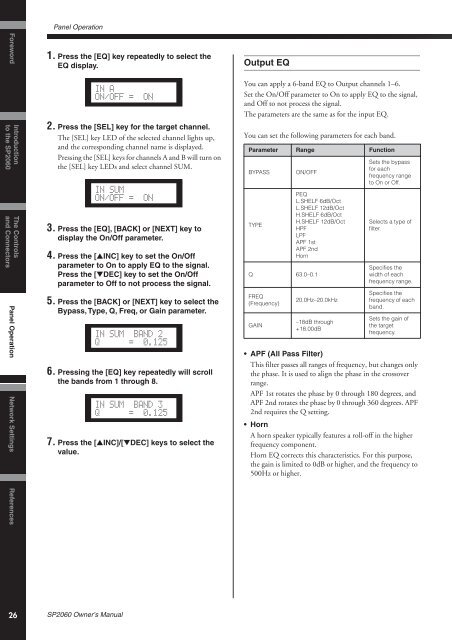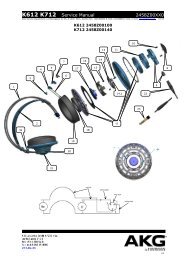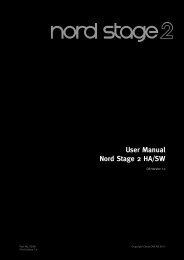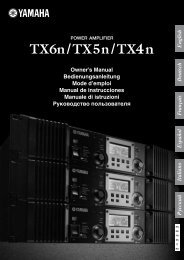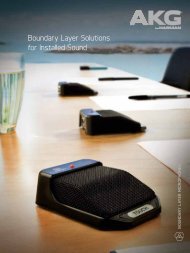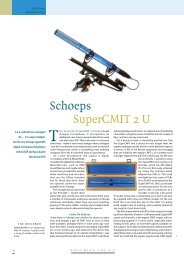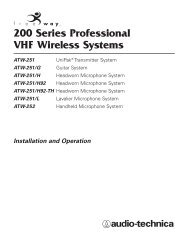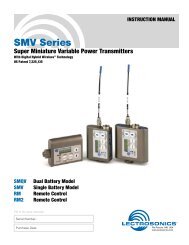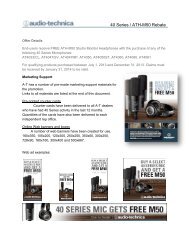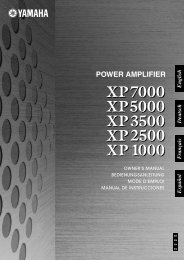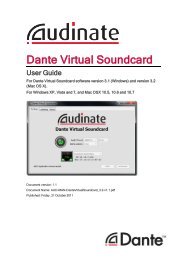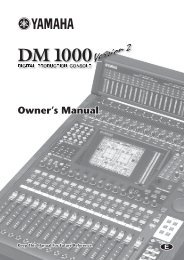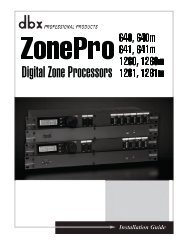Owner's Manual EN Page 2 The above warning is located on the top ...
Owner's Manual EN Page 2 The above warning is located on the top ...
Owner's Manual EN Page 2 The above warning is located on the top ...
Create successful ePaper yourself
Turn your PDF publications into a flip-book with our unique Google optimized e-Paper software.
Panel Operati<strong>on</strong><br />
Foreword Panel Operati<strong>on</strong><br />
Network Settings References<br />
Introducti<strong>on</strong><br />
to <strong>the</strong> SP2060<br />
<str<strong>on</strong>g>The</str<strong>on</strong>g> C<strong>on</strong>trols<br />
and C<strong>on</strong>nectors<br />
1. Press <strong>the</strong> [EQ] key repeatedly to select <strong>the</strong><br />
EQ d<str<strong>on</strong>g>is</str<strong>on</strong>g>play.<br />
IN A<br />
ON/OFF = ON<br />
2. Press <strong>the</strong> [SEL] key for <strong>the</strong> target channel.<br />
<str<strong>on</strong>g>The</str<strong>on</strong>g> [SEL] key LED of <strong>the</strong> selected channel lights up,<br />
and <strong>the</strong> corresp<strong>on</strong>ding channel name <str<strong>on</strong>g>is</str<strong>on</strong>g> d<str<strong>on</strong>g>is</str<strong>on</strong>g>played.<br />
Pressing <strong>the</strong> [SEL] keys for channels A and B will turn <strong>on</strong><br />
<strong>the</strong> [SEL] key LEDs and select channel SUM.<br />
IN SUM<br />
ON/OFF = ON<br />
3. Press <strong>the</strong> [EQ], [BACK] or [NEXT] key to<br />
d<str<strong>on</strong>g>is</str<strong>on</strong>g>play <strong>the</strong> On/Off parameter.<br />
4. Press <strong>the</strong> [▲INC] key to set <strong>the</strong> On/Off<br />
parameter to On to apply EQ to <strong>the</strong> signal.<br />
Press <strong>the</strong> [▼DEC] key to set <strong>the</strong> On/Off<br />
parameter to Off to not process <strong>the</strong> signal.<br />
5. Press <strong>the</strong> [BACK] or [NEXT] key to select <strong>the</strong><br />
Bypass, Type, Q, Freq, or Gain parameter.<br />
IN SUM BAND 2<br />
Q = 0.125<br />
6. Pressing <strong>the</strong> [EQ] key repeatedly will scroll<br />
<strong>the</strong> bands from 1 through 8.<br />
IN SUM BAND 3<br />
Q = 0.125<br />
7. Press <strong>the</strong> [▲INC]/[▼DEC] keys to select <strong>the</strong><br />
value.<br />
Output EQ<br />
You can apply a 6-band EQ to Output channels 1–6.<br />
Set <strong>the</strong> On/Off parameter to On to apply EQ to <strong>the</strong> signal,<br />
and Off to not process <strong>the</strong> signal.<br />
<str<strong>on</strong>g>The</str<strong>on</strong>g> parameters are <strong>the</strong> same as for <strong>the</strong> input EQ.<br />
You can set <strong>the</strong> following parameters for each band.<br />
Parameter Range Functi<strong>on</strong><br />
BYPASS<br />
TYPE<br />
ON/OFF<br />
Q 63.0–0.1<br />
FREQ<br />
(Frequency)<br />
GAIN<br />
PEQ<br />
L.SHELF 6dB/Oct<br />
L.SHELF 12dB/Oct<br />
H.SHELF 6dB/Oct<br />
H.SHELF 12dB/Oct<br />
HPF<br />
LPF<br />
APF 1st<br />
APF 2nd<br />
Horn<br />
20.0Hz–20.0kHz<br />
–18dB through<br />
+18.00dB<br />
Sets <strong>the</strong> bypass<br />
for each<br />
frequency range<br />
to On or Off.<br />
Selects a type of<br />
filter.<br />
Specifies <strong>the</strong><br />
width of each<br />
frequency range.<br />
Specifies <strong>the</strong><br />
frequency of each<br />
band.<br />
Sets <strong>the</strong> gain of<br />
<strong>the</strong> target<br />
frequency.<br />
• APF (All Pass Filter)<br />
Th<str<strong>on</strong>g>is</str<strong>on</strong>g> filter passes all ranges of frequency, but changes <strong>on</strong>ly<br />
<strong>the</strong> phase. It <str<strong>on</strong>g>is</str<strong>on</strong>g> used to align <strong>the</strong> phase in <strong>the</strong> crossover<br />
range.<br />
APF 1st rotates <strong>the</strong> phase by 0 through 180 degrees, and<br />
APF 2nd rotates <strong>the</strong> phase by 0 through 360 degrees. APF<br />
2nd requires <strong>the</strong> Q setting.<br />
• Horn<br />
A horn speaker typically features a roll-off in <strong>the</strong> higher<br />
frequency comp<strong>on</strong>ent.<br />
Horn EQ corrects th<str<strong>on</strong>g>is</str<strong>on</strong>g> character<str<strong>on</strong>g>is</str<strong>on</strong>g>tics. For th<str<strong>on</strong>g>is</str<strong>on</strong>g> purpose,<br />
<strong>the</strong> gain <str<strong>on</strong>g>is</str<strong>on</strong>g> limited to 0dB or higher, and <strong>the</strong> frequency to<br />
500Hz or higher.<br />
26<br />
SP2060 Owner’s <str<strong>on</strong>g>Manual</str<strong>on</strong>g>


